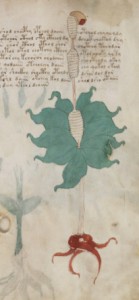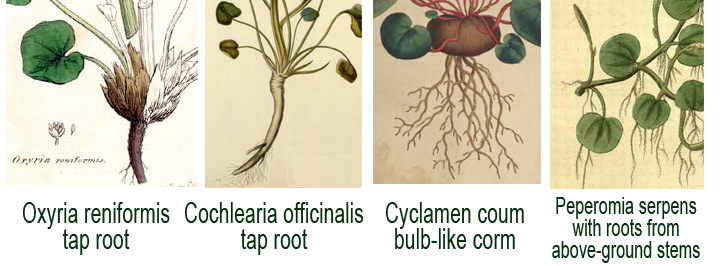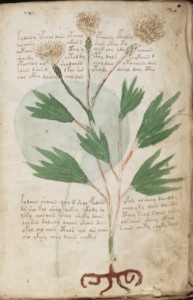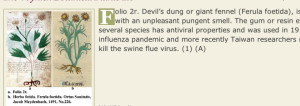Most of my notes about the Voynich and my plant identifications were done in 2007 and 2008. I glanced at the Voynich manuscript in the early hours of the morning when I should have been sleeping, amassed a database of over 13,000 plants (how, I don’t know since I had many personal responsibilities, was working very long hours and was not feeling well at the time) and came up with identifications for as many of the VM plants as possible. Those stolen minutes I spent with the VM were therapeutic for me. I have always loved both puzzles and plants.
After compiling my notes and cleaning them up toward the end of 2008, I looked around the Web to see what others had done and discovered that my identifications and theirs, except for some very obvious plants like the viola, didn’t match at all. At first this concerned me, but then I decided it was unimportant. They had their opinion, I had mine. Their identifications didn’t seem right to me and I decided to leave my notes as they were and let the world decide which ones were correct rather than stressing over the discrepancies. Except… that I never found time to upload them.
Far too many years went by before I set up this domain to share my thoughts with the Voynich community, and I find it somewhat shocking that life could speed from 2008 and 2013 with little more than a few glances at the document I so thoroughly loved. The VM gave me an escape from the daily stresses of coping with a globalizing economy and I had to give up even that.
So… the plant identifications I am uploading are grammatically comprehensible versions of my original notes from 2008 and what you see are my thoughts from five years ago. If I win a lottery and find some free time, I’ll read them over again and see if the information needs to be updated. As it is, this is the best I can do for now with what little free time I have.
The Spiny Fruit Plant
 The moment I saw it, Voynich 6v reminded me of spiny-fruit plants like chestnuts, the castor oil plant, datura, and wood avens.
The moment I saw it, Voynich 6v reminded me of spiny-fruit plants like chestnuts, the castor oil plant, datura, and wood avens.
Plant 6v features an upright, relatively slender stem, star-shaped leaves with seven lobes and a somewhat upright cluster of bluish-green “fruits”. There are small blue dots on the fruity shapes that may signify more spines pointing in the direction of the viewer or perhaps some other anatomical or color aspect of the plant.
There is a faint suggestion of a main vein on each of the leaf lobes and the leaf margins are serrated. The painting is somewhat rough and the blue ink appears to have been on the dry side when applied. No attempt was made to extend the ink into the spines, so either the painter couldn’t be bothered or didn’t have a fine enough brush, or wanted the spines to stand out as lighter than the rest of the plant.
The leaves are drawn opposite but the fruits are alternate and one fruit, a larger one, is oddly placed near the base of the plant. The roots are long and relatively slender, numerous, have not been colored in, and have a tendril-like character.
Integration with Text
The plant occupies most of the right-hand side of the page, stretching from the bottom to nearly the top, where it pokes into the upper lines of text except for the two lines at the top.
The text has been worked around the fruits at the top and continue down the rest of the page on the left, sometimes slightly crowding the drawing and almost overlapping.
Prior Identification
 Edith Sherwood has identified Plant 6v as Eryngium maritimum (sea holly), but I don’t see many commonalities other than color and the general arrangement of the leaves.
Edith Sherwood has identified Plant 6v as Eryngium maritimum (sea holly), but I don’t see many commonalities other than color and the general arrangement of the leaves.
Sea holly has the flower heads closely associated with the leaves—each head is perched tightly within a whorl of leaves. In contrast, the Voynich plant has a separate stem for each spiny head and there is no association with the heads and the leaves. The Voynich plant has a cluster of heads, whereas each sea holly head is perched on the end of a leafy stem and their shape tends to be slightly more conical than round.
Another significant difference between sea holly and the Voynich drawing is the association of the leaves with the stem. Sea holly leaves, which are more holly-like than star-like, are closely attached to the stem, whereas Plant 6v has distinct stems leading from the main stalk to the star-shaped leaves.
Finally, the leaves of sea holly are fairly deeply indented and pointy whereas the Voynich leaves have modest, even serrations that are more often found on soft-leaved plants.
Even if inexpertly drawn, I am inclined to believe the Voynich plants are somewhat botanically accurate even if sometimes stylized, and I doubt the illustrator would have completely dissociated the leaves from the heads and from the main stalk if this were intended to represent Eryngium maritimum.
If not Eryngium maritimum then what are plausible alternatives?
Alternative Identifications
Let’s discuss datura first, since I think it can be eliminated. Datura, also known as thorn apple or devil’s apple has spiny fruits somewhat like a chestnut, but they tend to be a little less round than the Voynich fruits and, depending on the species, the leaves are more palmate or sometimes similar to a dandelion shape than star-shaped. The veins in VM 6v leaves are distinctly placed in a star.
Chestnut trees (Aesculus and Castanea) are stately plants with somewhat star-shaped leaves and spiny fruits. In some species the fruits can be eaten. In others, they are toxic. The leaves of Aesculus more closely resemble Plant 6v than Castanea, but nevertheless differ in an important way—each of the lobes in the star is distinct from the leaf beside it and sometimes rounded at the attachment point instead of blending into the next lobe. While chestnut trees will occasionally have seven lobes, more often there are five or six.
Cyclanthera langaei has a star-like arrangement of leaves but, like Aesculus, the leaf lobes are distinct from each other rather than merging in the center and the spiny fruits are a little more elongated than the VM fruits. It is from a part of the world unknown to Europeans in the 15th century.
Magnolia hypoleuca has lobed leaves like Aesculus, but they typically have six lobes not seven and the spiny fruit is more elongated than the VM plant.
Ricinus communis is an age-old medicine and source of castor oil, which is used to treat constipation and sometimes skin conditions. Ricinus can also be highly toxic. Like VM 6v, the leaves of Ricinus are distinctly star-shaped with a prominent central vein and serrated margins. The fruits are round and stand on their own stem above the leaves and at some times of the year have a bluish-green color (at others times they are bright red).
The stems can be pale greenish or red and turn grayer as they get older. They are moderately slender compared to the overall proportions of the plant, making Ricinus a better candidate for the VM plant than chestnut trees, which have thick trunks. While Ricinus leaf lobes can vary, Ricinus communis very often has seven lobes. Ricinus leaves tend to be alternate and Plant 6v shows them as opposite, so the correspondence between them isn’t perfect, but enough elements match to give it some consideration.
It’s my opinion that of the plants mentioned so far, Ricinus communis has more characteristics in common with Plant 6v than the others.
Posted by J.K. Petersen

 Description
Description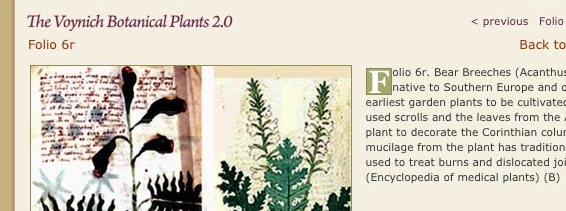











 Geranium robertianum (a very widespread plant also known as herb Robert) was used medicinally in the early days, and is still used as a mosquito repellent:
Geranium robertianum (a very widespread plant also known as herb Robert) was used medicinally in the early days, and is still used as a mosquito repellent:










